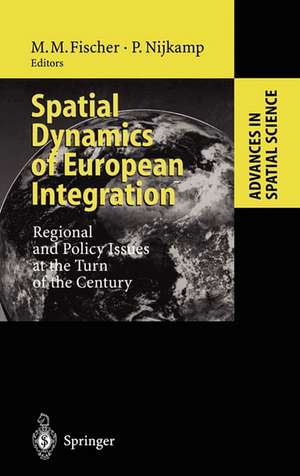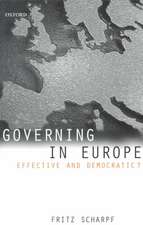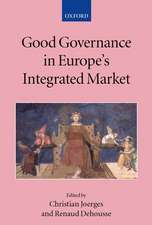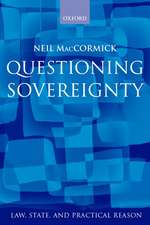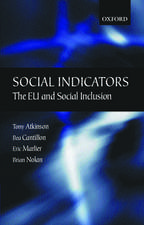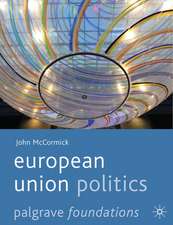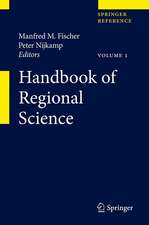Spatial Dynamics of European Integration: Regional and Policy Issues at the Turn of the Century: Advances in Spatial Science
Editat de Manfred M. Fischer, Peter Nijkampen Limba Engleză Hardback – 26 iul 1999
| Toate formatele și edițiile | Preț | Express |
|---|---|---|
| Paperback (1) | 948.61 lei 6-8 săpt. | |
| Springer Berlin, Heidelberg – 27 sep 2011 | 948.61 lei 6-8 săpt. | |
| Hardback (1) | 954.77 lei 6-8 săpt. | |
| Springer Berlin, Heidelberg – 26 iul 1999 | 954.77 lei 6-8 săpt. |
Din seria Advances in Spatial Science
-
 Preț: 368.92 lei
Preț: 368.92 lei - 18%
 Preț: 963.47 lei
Preț: 963.47 lei - 18%
 Preț: 948.16 lei
Preț: 948.16 lei - 18%
 Preț: 947.67 lei
Preț: 947.67 lei - 18%
 Preț: 940.72 lei
Preț: 940.72 lei - 18%
 Preț: 954.45 lei
Preț: 954.45 lei - 15%
 Preț: 646.62 lei
Preț: 646.62 lei - 18%
 Preț: 959.50 lei
Preț: 959.50 lei - 18%
 Preț: 956.33 lei
Preț: 956.33 lei - 18%
 Preț: 949.23 lei
Preț: 949.23 lei - 15%
 Preț: 646.75 lei
Preț: 646.75 lei - 15%
 Preț: 643.99 lei
Preț: 643.99 lei - 18%
 Preț: 955.40 lei
Preț: 955.40 lei - 15%
 Preț: 643.00 lei
Preț: 643.00 lei - 15%
 Preț: 644.49 lei
Preț: 644.49 lei - 18%
 Preț: 953.35 lei
Preț: 953.35 lei - 18%
 Preț: 956.03 lei
Preț: 956.03 lei - 15%
 Preț: 647.27 lei
Preț: 647.27 lei - 15%
 Preț: 638.24 lei
Preț: 638.24 lei - 18%
 Preț: 961.23 lei
Preț: 961.23 lei - 18%
 Preț: 954.93 lei
Preț: 954.93 lei - 15%
 Preț: 643.48 lei
Preț: 643.48 lei - 18%
 Preț: 955.70 lei
Preț: 955.70 lei - 15%
 Preț: 650.86 lei
Preț: 650.86 lei - 15%
 Preț: 650.04 lei
Preț: 650.04 lei - 15%
 Preț: 648.42 lei
Preț: 648.42 lei - 18%
 Preț: 949.42 lei
Preț: 949.42 lei - 18%
 Preț: 960.30 lei
Preț: 960.30 lei - 18%
 Preț: 948.29 lei
Preț: 948.29 lei - 18%
 Preț: 958.07 lei
Preț: 958.07 lei - 18%
 Preț: 950.66 lei
Preț: 950.66 lei - 18%
 Preț: 956.03 lei
Preț: 956.03 lei - 15%
 Preț: 643.65 lei
Preț: 643.65 lei - 18%
 Preț: 956.99 lei
Preț: 956.99 lei - 18%
 Preț: 956.81 lei
Preț: 956.81 lei - 18%
 Preț: 958.73 lei
Preț: 958.73 lei - 18%
 Preț: 959.98 lei
Preț: 959.98 lei - 18%
 Preț: 952.40 lei
Preț: 952.40 lei - 15%
 Preț: 643.00 lei
Preț: 643.00 lei
Preț: 954.77 lei
Preț vechi: 1164.35 lei
-18% Nou
Puncte Express: 1432
Preț estimativ în valută:
182.75€ • 198.58$ • 153.61£
182.75€ • 198.58$ • 153.61£
Carte tipărită la comandă
Livrare economică 21 aprilie-05 mai
Preluare comenzi: 021 569.72.76
Specificații
ISBN-13: 9783540658177
ISBN-10: 3540658173
Pagini: 384
Ilustrații: XII, 367 p.
Dimensiuni: 155 x 235 x 28 mm
Greutate: 0.71 kg
Ediția:1999
Editura: Springer Berlin, Heidelberg
Colecția Springer
Seria Advances in Spatial Science
Locul publicării:Berlin, Heidelberg, Germany
ISBN-10: 3540658173
Pagini: 384
Ilustrații: XII, 367 p.
Dimensiuni: 155 x 235 x 28 mm
Greutate: 0.71 kg
Ediția:1999
Editura: Springer Berlin, Heidelberg
Colecția Springer
Seria Advances in Spatial Science
Locul publicării:Berlin, Heidelberg, Germany
Public țintă
Professional/practitionerCuprins
1 Spatial Dynamics of European Economic Integration: Prologue.- A: European Monetary Unification and Implications.- 2 Winners and Losers in the European Monetary Union: A Neural Network Analysis of Industrial Spatial Shifts.- 3 Costs of European Monetary Union: Evidence of Monetary and Fiscal Policy Effectiveness.- 4 Specialisation in Europe and Asymmetric Shocks: Potential Risks of EMU.- 5 The Regional Impact of the Single Currency.- 6 Trade and Investments in the EMU Regions.- 7 Convergence of European Financial Systems: Banks or Equity Markets?.- B: Economic Integration, Cohesion and Regional Policy.- 8 The Dynamics of Economic Integration and Cohesion in the EU: Experiences from the Past and Challenges for the Future.- 9 The Control of Regional State Aid under EU Competition Policy and Its Effects on Economic and Social Cohesion.- 10 On-Going European Integration and the Position of the Regions: An Analysis of the Process and Some Possible Future Scenarios.- 11 Convergence, Dualism and Regional Disparities: The Italian Case.- 12 Capital and Labour Productivity Convergence of Manufacturing Industry in the Regions of Greece.- 13 Prospects of the Finnish Regional Development under EMU and Deepening Integration.- C: Community Enlargement Towards Central and Eastern Europe: Problems and Prospects.- 14 The Problem of Transition and Reintegration of East and Central Europe: Conceptual Remarks and Empirical Problems.- 15 The Central and Eastern European Union Enlargement and the EMU: Nominal Convergence and the Optimum Currency Areas Approach.- 16 The Dutch Golden Age and the Rise of Capitalism in Central and Eastern Europe: A Neo-Institutional Comparative Analysis.- 17 Economic Impacts of the EU Enlargement on Austrian Regions.- Author Index.- List of Contributors.
Caracteristici
Addresses important policy and research questions concerning the European Monetary Union and the enlargement of the EU towards Central and Eastern Europe Emphasizes the regional and industrial consequences of European dynamics Covers macroeconomic and regional distributional aspects of European integration Provides important new departures for a better understanding of spatial-economic developments in Europe
